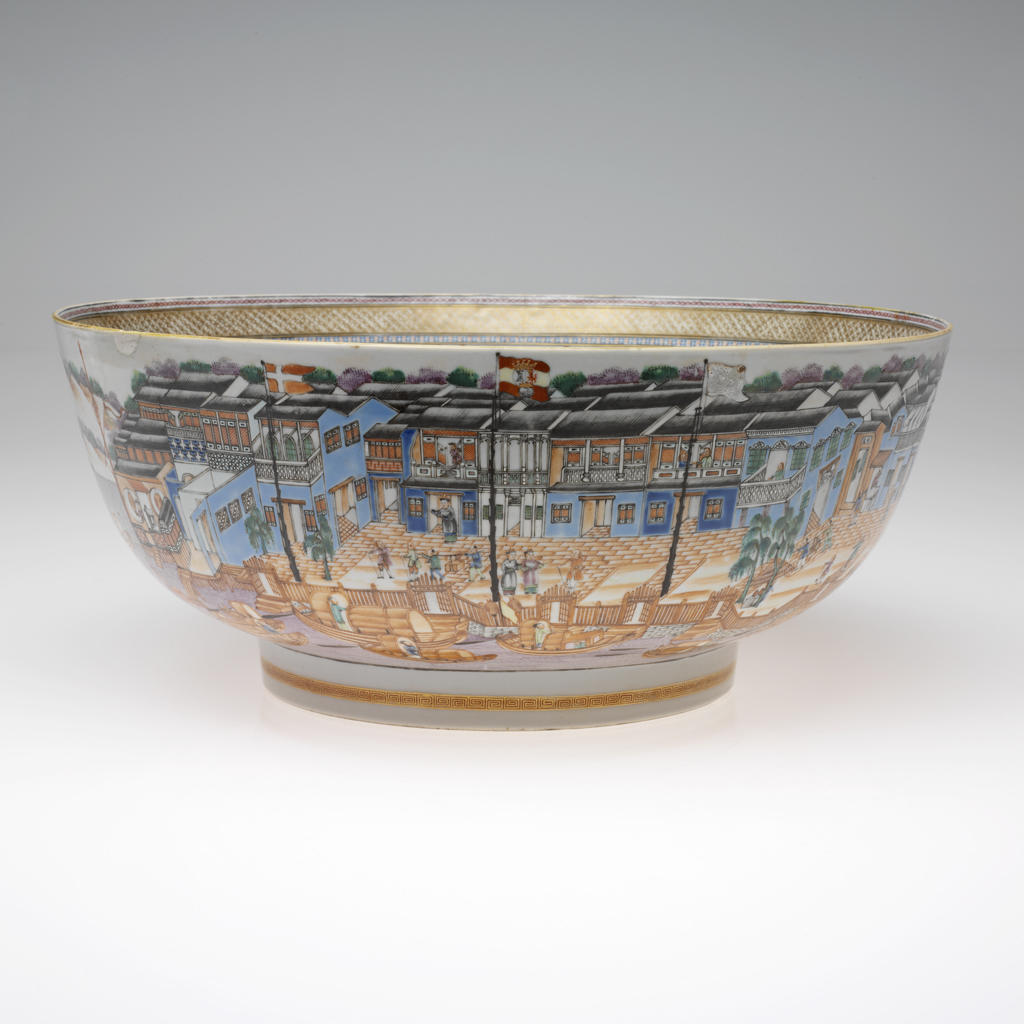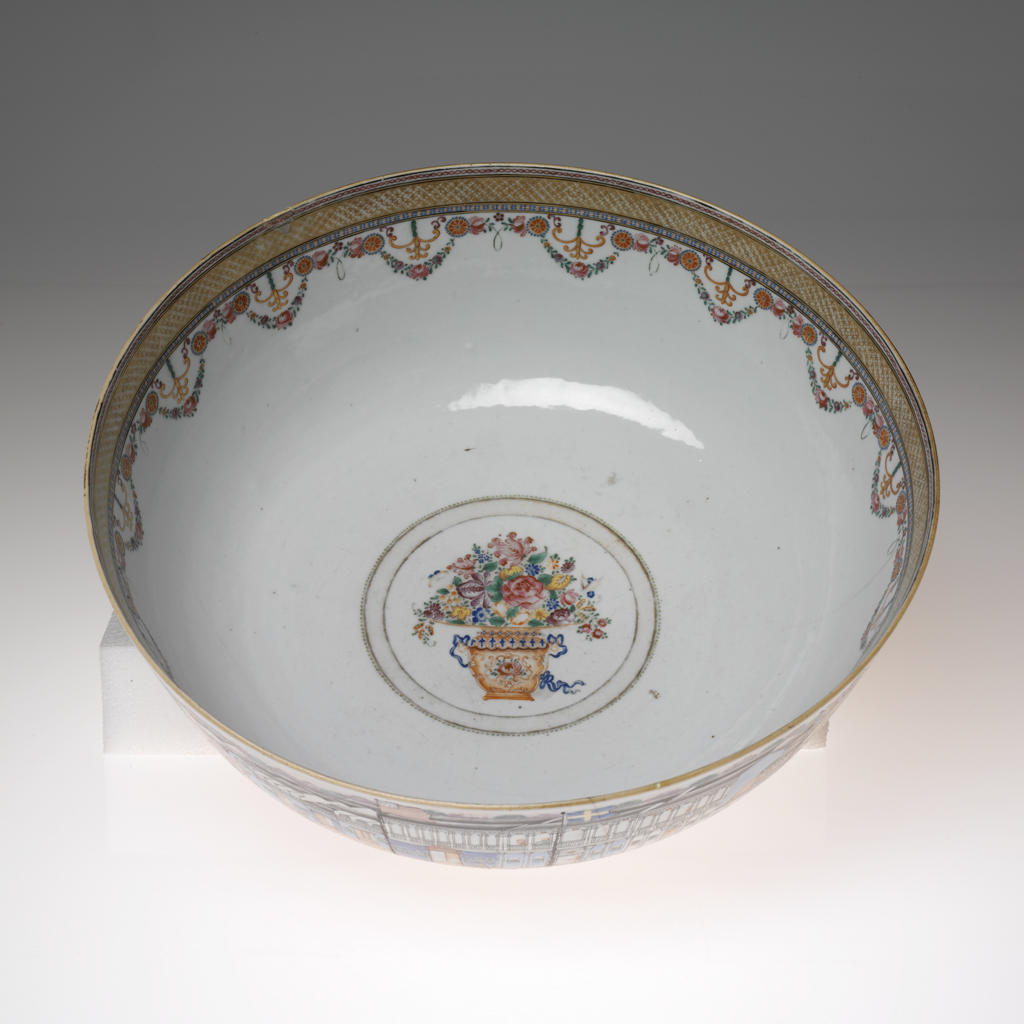This large porcelain punch bowl offers us a glimpse into the lives of international merchants in Canton, China. Not only can we see their homes and warehouses, called hongs, but people are also depicted in boats and houses, playing on the street and engaged in business. Vibrant colors create a beautiful scene showing the structured order of the hongs while imparting a sense of the hustle and bustle that goes hand in hand with a booming commercial center. The bowl gives us insight into the life of the American merchant who likely purchased it: it presents an image of his home in a foreign place. Flags from Sweden, Great Britain, the Netherlands, Denmark, Spain, the French Royal Navy, and the United States are on display, indicating that the bowl was produced after the 1784 arrival of American merchants in Canton.1 Bowls of this kind, known to have been popular through the end of the 18th century, and other impressive objects spoke to the American desire for recognition, prosperity, and status. This bowl also depicts the United States’ first direct engagement with the international economy characterized by global trade networks.
From their founding, the American colonies were tied to a trade economy that avidly sought goods from the East.2 Spices were in demand throughout Europe and its colonies not only to add flavor to foods but to disguise the taste of rancid meat in a world without refrigeration. European merchant ships circumnavigated Africa to reach the East, returning to Europe carrying precious cargoes of spices, tea, and silk. These ships also carried porcelain as ballast.3 Though not a primary object of trade with the East, these delicate white-bodied ceramics became a highly desired luxury and status item in Europe and North America in the 17th and 18th centuries.4 Prior to 1776, American merchants could only obtain Asian goods through trade with England.5 American merchants were barred from all British harbors at the close of the American Revolution in 1783, and they wasted no time in seeking new ports.6 Canton, China was one of the first destinations, with an initial visit in 1784 ushering in a lucrative era for American merchants in the Eastern trade.7
Chinese porcelain marks the pinnacle of ceramic production;8 good-quality Chinese porcelain such as this bowl is made by firing white kaolin clay with a high feldspar content at a very high temperature, causing the feldspar in the clay to vitrify and producing a hard, translucent ceramic with a glossy exterior.9 Documents written by a Chinese master potter in the 18th century indicate that the kaolin clay, derived from Qimen, was “washed, crushed, and then rewashed several times. After cleaning it was strained through a sieve constructed of horsehair, then through a bag made of two thicknesses of silk,” after which it was formed into slabs, air dried, and transported to the pottery workshops where it was washed and purified again.10
After being formed, works in porcelain were hand painted with underglazes or, as was the case for this bowl, fired and then painted with overglaze enamel.11 A piece with this level of intricacy would have required numerous layers of enamel; the base colors for all of the buildings, boats, streets, and water in the design would have been painted first and allowed to dry before details like people, street tiles, and architectural embellishments on the houses could be added.12 Finally, the bowl was gilded along the interior of the rim and the exterior of the foot, a key feature that distinguishes this variation of the Canton motif from two other known examples of Canton decorative schemes.13
The presence of the new American flag with those of other established nations on the Hong bowl speaks to a status and recognition that the fledgling country might not have commanded at the time, but aspired to. A symbol of the United States’ first forays into global trade, commemorated by Chinese ceramicists, the Hong punch bowl offers a glimpse into the perceptions of the former American colonies at home and abroad and the dynamics of international trade in the late 18th century.
Jessica Nelson
Anthropology PhD student, Brown University
- 1 Thomas S. Michie, article in Curatorial File: Hong Bowl PDF (Providence: Rhode Island School of Design, 2013), 11 and 21.
- 2Ibid., 27.
- 3Ibid., 29.
- 4Ivor Noël Hume, “Porcelain, Chinese,” in A Guide to Artifacts of Colonial America (Philadelphia: University of Pennsylvania Press, 1969), 257.
- 5eemu Ruskola, “Canton is Not Boston: The Invention of American Imperial Sovereignty,” American Quarterly, 57(3), 2005: 865.
- 6Michie, Hong Bowl PDF, 27.
- 7James C. Thomson, Peter W. Stanley, and John Curtis Perry, Sentimental Imperialists: The American Experience in East Asia (New York: Harper and Row Publishers, New York, 1981), 9.
- 8Prudence M. Rice, Pottery Analysis: A Sourcebook (Chicago: University of Chicago Press, 1987), 6.
- 9Ibid.
- 10Ibid., 123-124.
- 11Noël Hume, “Porcelain, Chinese” (1969), 261.
- 12Ibid., 21.
- 13Ibid.

